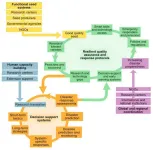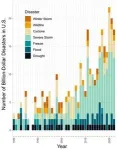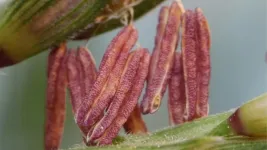(Press-News.org) An often-overlooked component of natural and human-driven disasters is their potential to affect plant health and thus food security at domestic and international scales. Most disasters have indirect effects on plant health through factors such as disruptions to supply chains and damaged infrastructure, but there is also the potential for direct effects from disasters, such as pathogen or vector dispersal caused by floods, hurricanes, and human migration. These occurrences are rarely isolated and instead often occur simultaneously. We have seen examples of the concurrence of disasters in recent history through events such as market disruptions in the early days of the COVID-19 pandemic; the intense wildfires, hurricanes, and tornadoes that have ravaged in the years since 2020; the Ukraine-Russia war disrupting the global wheat supply; and so on.
The impacts of natural disasters on plant health can be seen after events such as when the soybean rust pathogen, Phakopsora pachyrhizi, was first detected in the United States in Louisiana shortly after Hurricane Ivan in 2004. Hurricane Ivan moved north from the lower Caribbean near Colombia and is believed to have moved spores into the United States. Insect pests can also travel long distances during strong wind events. Bean golden yellow mosaic virus was likely introduced to Florida by Hurricane Andrew in 1992, which carried viruliferous whiteflies from the Caribbean islands. Bean golden yellow mosaic virus caused the reduction or collapse of bean production the following year and became established in Florida. Wildfires also pose a significant risk for the spread of plant pathogens. Fire can damage forest ecosystems, leaving gaps that become habitats open to colonization by invasive pests and pathogens. For example, wildfires in California devastated the coastal mountain range, and new plantings to restore these areas were unknowingly contaminated with Phytophthora tentaculata, a quarantined pathogen that can cause root and crown rot. This has led to more complications, as forest managers now need to control both introduced diseases and future wildfires.
Human-driven disasters, such as armed conflicts, can also create conditions that are favorable to the spread of plant pathogens, leading to devastating consequences for crop production, food security, and overall instability in affected regions. Unrest may force farmers to rely on poor-quality seed with higher risk of disease, resulting in low yields. The current war in Ukraine is an example of how all countries are vulnerable to armed conflict, which not only leads to crop loss and disease spread but also disrupts the global exchange of commodities. The invasion of Ukraine disrupted the global wheat supply and caused a 50% increase in global fertilizer prices due to Russia's significant role as a supplier, accounting for 13% of the world's fertilizer production. In the twenty-first century, poverty, political unrest, and inefficient regulation have significantly influenced the development of major plant disease epidemics.
With the increase in frequency and severity of these disasters, a cross-disciplinary team of researchers and humanitarian experts from the United States, Benin, Ecuador, Kenya, the Netherlands, Peru, Tanzania, and Thailand and led by Berea Etherton from the Garrett Lab (www.garrettlab.com) at the University of Florida, Gainesville, published “Disaster Plant Pathology: Smart Solutions for Threats to Global Plant Health from Natural and Human-Driven Disasters” in the journal Phytopathology. The framework highlighted in the article by Etherton et al. provides a multidisciplinary perspective on current threats and solutions to plant health and food security, encompassing the risk from environmental factors such as climate change, while also including factors such as political instability and war. The international team utilized the One Health framework, which addresses the interconnections among human, animal, plant, and environmental health. Disaster plant pathology provides a framework focusing on the impact of disasters on plant health, plant pathogens, and agricultural systems for tailored solutions and informed decision making. This framework promotes interdisciplinary collaboration, making it of common interest for communities of plant pathologists, humanitarian groups, economists, computer scientists, meteorologists, and sustainable development strategists.
Disaster plant pathology offers solutions through “smart agriculture.” Utilization of the robust capabilities of artificial intelligence (AI) can provide early warning information systems, risk assessment, crop monitoring, supply chain optimization, decision-support, real-time monitoring, and resilience strategies. There is potential for farmers and agricultural authorities to use these tools to make informed decisions and facilitate recovery efforts, thus minimizing the impact of disasters on agricultural systems. Through the integration of satellite imagery, weather data, disease incidence reports, early warning systems, and other relevant information, these models can identify patterns and predict the trajectory of pathogen movement. Farmers and agricultural authorities can use these models to take preventive measures in areas at high risk of infection, effectively managing the spread of disease and accelerating recovery.
The interactions among natural and human-driven disasters, plant disease, and global food security are critical concerns that demand expertise and knowledge from scientists working in disaster plant pathology. Disaster plant pathology recommends actions for improving food security before and following disasters, including (i) strengthening regional and global cooperation, (ii) capacity building for rapid implementation of new technologies, (iii) effective clean seed systems that can act quickly to replace seed lost in disasters, (iv) resilient biosecurity infrastructure and risk assessment ready for rapid implementation, and (v) decision support systems that can adapt rapidly to unexpected scenarios.
Through predictive analyses, early warning systems, and real-time crop monitoring, humanitarian aid and governmental interventions can help to ensure the quality and safety of agricultural production for growers. The experts behind disaster plant pathology hope this framework incites collaboration at an international scale. Lead author Berea Etherton said: “Our team of global researchers and humanitarian experts synthesized current knowledge about disaster effects and strategies for planning and response. We developed this new perspective, disaster plant pathology, so that others working to protect plant health and food security can build on it.” These intricate relationships require global cooperation, and in the face of climate change and geopolitical complexities, a collective and proactive response is needed to protect plant health.
For additional details on the disaster plant pathology framework, read “Disaster Plant Pathology: Smart Solutions for Threats to Global Plant Health from Natural and Human-Driven Disasters” published in the Key Challenges focus issue (volume 114, number 5) of Phytopathology.
Follow the authors on X
Berea Etherton (@Berea_Etherton), Karen Garrett (@Garrett_Lab), Robin Choudhury (@rob_choudhury), Jorge Andrade-Piedra (@jandrade2221), Kwame Ogero (@OgeroKo), Israel Navarrete (@isranavarrete_)
Institutions: University of Florida Plant Pathology Department (@UFPlantPath), University of Florida Global Food Systems Institute (@UF_IFAS_GFSI), CGIAR (@cgiar), International Potato Center (@cipotato), Alliance of Bioversity International and the International Center for Tropical Agriculture (@BiovIntCIAT_eng)
About Phytopathology
For over 100 years Phytopathology® has been the premier international journal for publication of articles on fundamental research that advances understanding of the nature of plant diseases, the agents that cause them, their spread, the losses they cause, and measures used to control them. Articles are characterized by their novelty, innovativeness, and the hypothesis-driven nature of their research.
END
Disaster plant pathology: solutions to combat agricultural threats from disasters
2024-08-07
ELSE PRESS RELEASES FROM THIS DATE:
Higher glucose levels worsen prognosis in ischemic stroke patients
2024-08-07
Having higher than usual blood sugar levels at the time of hospital admission for an ischemic stroke significantly increases the risk of a poor functional prognosis or death within three months of the stroke. This is the main conclusion of a study by the Endocrinology and Nutrition Services and the Neurology Department of Hospital del Mar, with researchers from the hospital's Research Institute, the RICORS-ICTUS network, and the CIBER of Diabetes and Associated Metabolic Diseases (CIBERDEM). The study ...
USC Norris Comprehensive Cancer Center to Open Radiation Oncology and Imaging Center in Newport Beach
2024-08-07
LOS ANGELES — USC Norris Comprehensive Cancer Center, part of Keck Medicine of USC, will open a Newport Beach location offering the latest advancements in radiation therapy and diagnostic imaging. The treatment center, which will open in early 2025, will feature cutting-edge cancer technologies that are yet to be available in Orange County, providing new therapeutic options and optimizing patient outcomes.
The new location address is 4590 MacArthur Blvd. in Newport Beach, less than 15 minutes away from USC Norris’ oncology centers in Newport Beach and Irvine. Those centers are staffed by respected oncologists who have served Orange County for decades, ...
MD Anderson Research Highlights for August 7, 2024
2024-08-07
HOUSTON ― The University of Texas MD Anderson Cancer Center’s Research Highlights showcases the latest breakthroughs in cancer care, research and prevention. These advances are made possible through seamless collaboration between MD Anderson’s world-leading clinicians and scientists, bringing discoveries from the lab to the clinic and back.
Recent developments at MD Anderson include insights into evolutionary cellular adaptations to environmental stressors, potential targets to overcome trouble swallowing in head and neck cancer patients treated with radiation therapy, a promising chemotherapy-free ...
Some e-cigarette chemicals mimic nicotine, possibly bypassing regulation
2024-08-07
DURHAM, N.C. – In what appears to be an effort to bypass public health regulations covering vaping products, some tobacco companies have begun replacing nicotine in e-cigarettes with related chemicals that have similar properties but unknown health effects, Duke Health researchers report.
In a research letter appearing Aug. 7 in JAMA, study authors at Duke and Yale University also found that the quantity of these chemicals, known as nicotine analogs, are not accurately disclosed on the packaging.
“Vaping products containing nicotine are subject to federal laws that prohibit sales to people under the age of 21,” said study co-author Sairam V. Jabba, ...
New 400-year temperature record shows Great Barrier Reef is facing catastrophic damage, researchers warn
2024-08-07
The Great Barrier Reef is under critical pressure, with warming sea temperatures and mass coral bleaching events threatening to destroy the remarkable ecology, biodiversity, and beauty of the world’s largest coral reef, according to new research published today.
‘Highest ocean heat in four centuries places Great Barrier Reef in danger’, published in Nature (8 August), led by University of Wollongong (UOW) Honorary Fellow and University of Melbourne Lecturer Dr Benjamin Henley, provides new evidence of the impact that rising sea surface temperatures ...
Corn’s ‘missing link’
2024-08-07
Cold Spring Harbor Laboratory (CSHL) has begun to unravel a mystery millennia in the making. Our story begins 9,000 years ago. It was then that maize was first domesticated in the Mexican lowlands. Some 5,000 years later, the crop crossed with a species from the Mexican highlands called teosinte mexicana. This resulted in cold adaptability. From here, corn spread across the continent, giving rise to the vegetable that is now such a big part of our diets. But how did it adapt so quickly? What biological mechanisms allowed the highland crop’s traits to take hold? Today, a potential answer emerges.
CSHL Professor and HHMI Investigator Rob Martienssen had ...
Scientists uncover hidden forces causing continents to rise
2024-08-07
Scientists at the University of Southampton have answered one of the most puzzling questions in plate tectonics: how and why ‘stable’ parts of continents gradually rise to form some of the planet’s greatest topographic features.
They have found that when tectonic plates break apart, powerful waves are triggered deep within the Earth that can cause continental surfaces to rise by over a kilometre.
Their findings help resolve a long-standing mystery about the dynamic forces that shape and connect some of the Earth’s most ...
Variability in constituents of e-cigarette products containing nicotine analogues
2024-08-07
About The Study: Discrepancies were observed between labeled and measured concentrations of nicotine analogues in e-cigarettes and e-cigarette liquids marketed as nicotine replacements and exempt from FDA’s regulatory purview. Such discrepancies may lead to uncertainty about user exposure. When coupled with the largely unknown acute and chronic inhalation hazards and addictive potential of nicotine analogues, assessing product risk based on exposure becomes challenging from a clinical and regulatory standpoint. With e-cigarettes increasingly considered for smoking cessation, the advent of nicotine analogue–containing products with ...
A vaping cessation text message program for adolescent e-cigarette users
2024-08-07
About The Study: A tailored, interactive text message intervention increased self-reported vaping cessation rates among adolescents recruited via social media channels.
Quote from corresponding author Amanda L. Graham, PhD:
“Health care providers, teachers, and parents have been asking how to help teens quit vaping. This study is a critical breakthrough that demonstrates the power of a behavioral intervention for vaping cessation. Text messages serve as powerful reminders of an initial commitment to quit and can deliver proven behavior change support right to a young person’s phone.
“We also did not see evidence that teens who quit ...
Neighborhood socioeconomic disadvantage across the life course and premature mortality
2024-08-07
About The Study: Low neighborhood socioeconomic status was associated with premature mortality in this study. The risk of premature mortality was greatest among individuals experiencing persistently low neighborhood socioeconomic status from young to middle adulthood. Place-based interventions that target neighborhood social determinants of health should be designed from a life course perspective that accounts for early-life socioeconomic inequality.
Corresponding Author: To contact the corresponding author, Wayne R. Lawrence, DrPH, email wayne.lawrence@nih.gov.
To access the embargoed ...




